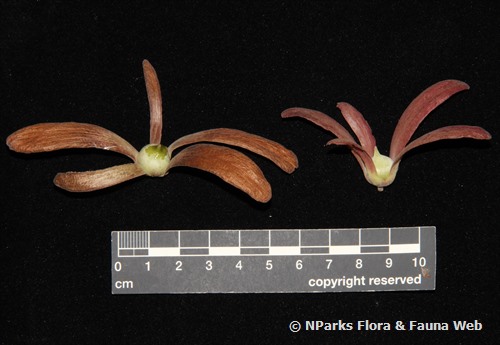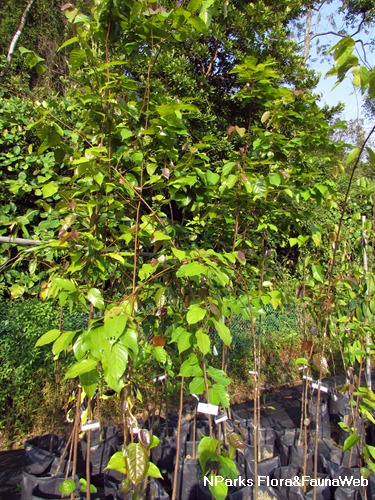
Name
Classifications and Characteristics
| Plant Division | Angiosperms (Flowering Seed Plants) |
|---|---|
| Plant Growth Form | Tree (Big (>30m)) |
| Lifespan (in Singapore) | Perennial |
| Maximum Height | 50 m |
Biogeography
| Native Distribution | From India to Nepal |
|---|---|
| Native Habitat | Terrestrial |
| Preferred Climate Zone | Sub-Tropical / Monsoonal |
| Local Conservation Status | Non-native |
Description and Ethnobotany
| Growth Form | Shorea robusta is a large tree 45-50m tall; trunk to 5m dbh (diameter at breast height). However, most trees would normally attain a height of 18-32 m, with a dbh of 1.5-2m. |
|---|---|
| Crown | The Sal tree has a spreading and spherical crown |
| Trunk | The bark is deeply fissured in younger specimens of Shorea robusta, but the fissures gradually becomes more shallow as the tree matures. |
| Roots | This species has a tendency to develop a long and deep tap root even at a very young age. |
| Foliage | The leaves of the Sal tree are oblong to oval, 10-20cm long by 6-12 cm wide, with 12-14 pairs of lateral veins. |
| Flowers | The flowers of Shorea robusta are cream- yellow, about 2cm across, and are carried in large and showy clusters. The flowers are pollinated by Thrips (Insects from the order Thysanoptera). |
| Fruit | The small fruit is oval in shape and measure about 0.8-1 cm in diameter. Each fruit comes with 5 wings that measure 5 - 7.5 cm in length, and of which 3 are longer than the other 2. |
| Habitat | Shorea robusta occurs in deciduous (moist or dry) forests and can be found from sea level to about 1,500m. However, it is not common above 1,000m above sea level. It is estimated that the Sal tree makes up some 14% of India's total forested area. It is likewise dominat in some parts of Nepal. |
| Ethnobotanical Uses | Edible Plant Parts : Edible Seeds Food (Fruit or Vegetable): In India, the seeds are also cooked into a porridge with other ingredients. The seeds are also ground into a coarse flour to make bread, and oil from the seeds of the Sal tree is also extracted commercially and used as a substitute for cocoa butter. The 'Seed butter' is also used in cooking, and the plant itself is also consumed, but only as faine food. Timber & Products: In India and parts of Nepal, Shorea robusta is the predominant hardwood species that is used in construction, where it is used in the building of houses, ships, railway cars, as well as in hydraulic engineering. The wood is highly resistant to termites, and very durable. Agriculture - Forestry: Shorea robusta has been grown alongside with Tectona grandis (Teak) in mixed plantations, with good results. Others: The leaves of Shorea robusta are also harvested to make hats, as well as lacquered plates and bowls. The leaves are also used as cattle fodder. |
Landscaping Features
| Desirable Plant Features | Ornamental Form |
|---|---|
| Landscape Uses | Parks & Gardens |
| Thematic Landscaping | Economic Garden |
Fauna, Pollination and Dispersal
| Pollination Method(s) | Biotic (Fauna) |
|---|---|
| Seed or Spore Dispersal | Abiotic |
Plant Care and Propagation
| Light Preference | Full Sun |
|---|---|
| Water Preference | Moderate Water |
| Plant Growth Rate | Moderate |
| Rootzone Tolerance | Drought Tolerant, Moist Soils, Well-Drained Soils, Fertile Loamy Soils |
| Planting Remarks | This species does best in a moist but well drained, sandy-loam based mix. It does not tolerate waterlogged soils and heavy clay soils. |
| Propagation Method | Seed |
Foliar
| Foliage Retention | Deciduous, Drought / Semi-Deciduous |
|---|---|
| Mature Foliage Colour(s) | Green |
| Foliage Retention Remarks | This species is fully deciduous when cultivated in climates with a long and distinct dry season, |
Floral (Angiosperm)
| Flower Colour(s) | Yellow / Golden |
|---|---|
| Flower Grouping | Cluster / Inflorescence |
Fruit, Seed and Spore
| Mature Fruit Colour(s) | Brown |
|---|
Image Repository
Others
| Master ID | 32312 |
|---|---|
| Species ID | 6720 |
| Flora Disclaimer | The information in this website has been compiled from reliable sources, such as reference works on medicinal plants. It is not a substitute for medical advice or treatment and NParks does not purport to provide any medical advice. Readers should always consult his/her physician before using or consuming a plant for medicinal purposes. |




_lowres.jpg)


